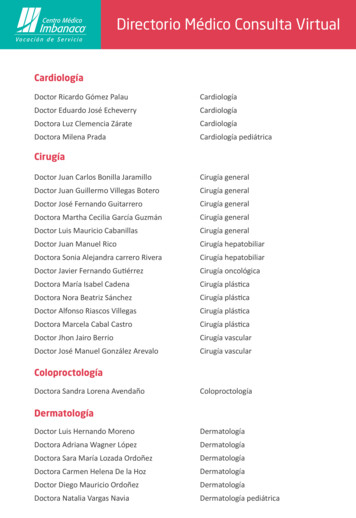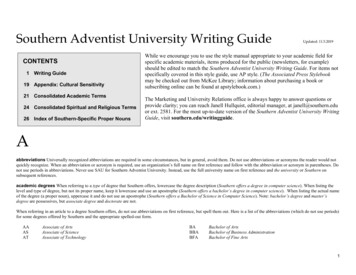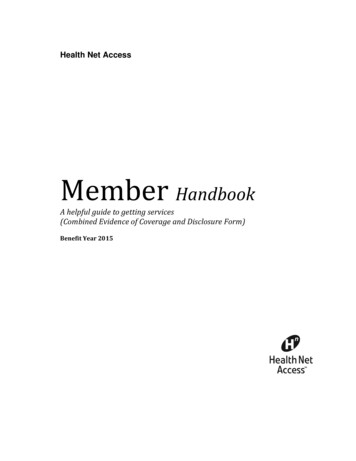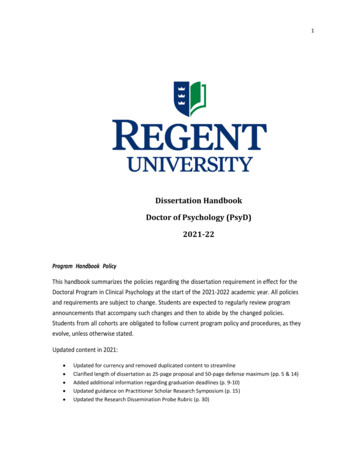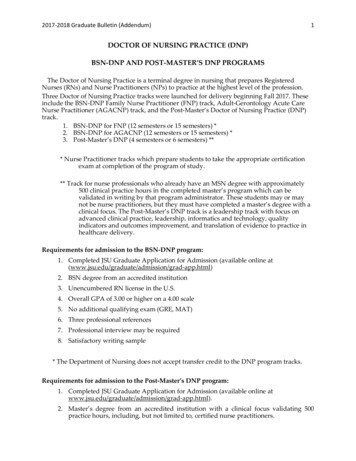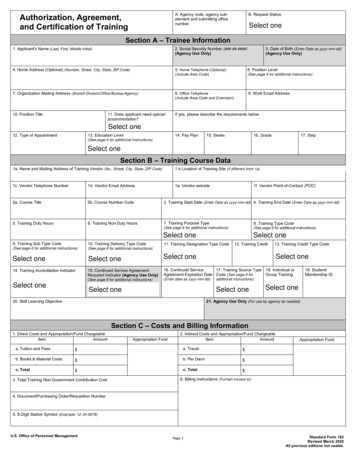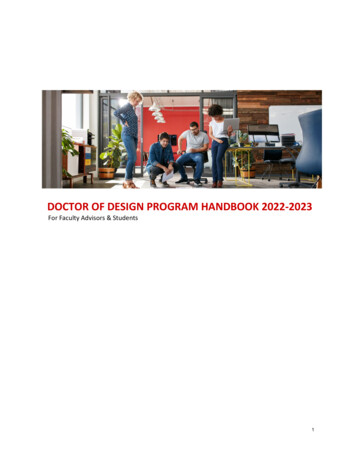
Transcription
DOCTOR OF DESIGN PROGRAM HANDBOOK 2022-2023For Faculty Advisors & Students1
WELCOMEContentsOVERVIEW OF THE PROGRAM45REQUIRED IMMERSION EXPERIENCE5CURRICULUM STRUCTURE5NC STATE UNIVERSITY: MISSION AND VALUES6COLLEGE OF DESIGN: MISSION AND VALUES6DOCTOR OF DESIGN PROGRAM: PURPOSE AND STRATEGIC GOALS6DDES PROGRAM FACULTY & STAFFACCESSIBILITYDOCTORAL DEGREE: CHECKLIST OF REQUIREMENTSCURRICULUM & ADVISING88910CURRICULUM & COURSE REQUIREMENTS10PROGRAM PACING11FORMING A DISSERTATION ADVISORY COMMITTEE12GRADUATE PLAN OF WORK & COMMITTEE CHANGES13RESEARCH PROPOSAL14PRELIMINARY EXAMINATION16EXAMINATION FORMAT16THE DISSERTATION18FINAL ORAL EXAMINATION19DISSERTATION SUBMISSION PROCEDURES20TIME LIMITS22FINANCIAL ASSISTANCE23REGISTRATION27ADVISING RELEASE27CONTINUOUS REGISTRATION27LEAVE OF ABSENCE27PART-TIME OR NON-DEGREE STUDENT REGISTRATION STATUS27ADJUSTMENTS TO COURSE SELECTION29WITHDRAWAL29REGISTRATION IN SUMMER SESSIONS30INCOMPLETE GRADES302
FAILURE TO MAINTAIN CONTINUOUS REGISTRATION31FULL-TIME/PART-TIME STATUS OF DOCTORAL STUDENTS31REQUIREMENTS FOR RESIDENCY CREDIT31APPENDICES32APPENDIX A: CURRENT DDES FACULTY, ADVISORS, AND STEERING COMMITTEE MEMBERS32APPENDIX B: RESEARCH CENTERS AND INITIATIVES35APPENDIX C: ACADEMIC CALENDARS36APPENDIX D: NC STATE GRADUATE HANDBOOK36APPENDIX E: CONTINUING STUDENT ANNUAL ASSESSMENT373
WELCOMEWelcome to the Doctor of Design program at the College of Design, North Carolina State University! This Fall(2022), the Doctor of Design program (DDes) begins its fifth year of unique transdisciplinary online education.We are excited to welcome Cohort Five--our newest diverse cohort of student-practitioners--and toreconnect with those of you who are returning to continue your studies.The goal of our program is to advance the life-changing power of design, at every level, and enable diversepractitioners to transcend the limits and boundaries of traditional professional training. We are proud of themany assets of the College of Design—especially our DDes faculty, staff, and student-practitioners, workingtogether on innovation and discovery in, for, and through design. We have therefore designed the DDesprogram to provide you with relevant research frameworks, concepts, mentors, and exemplars forcontemporary design practices.To help guide, support, and challenge your individual investigations, DDes students may choose to marshalresources from the College of Design, as well as other colleges at NC State University, and/or otheruniversities in the North Carolina University System. However, in teaching and learning from exemplarsdrawn from many disciplines, other sectors, or emerging types of practices, please note: peer members ofyour class may be among your greatest teachers.This is all to say, our greatest resource is you—you student-practitioners and risk-takers—and yourtransformative leadership potential for design and for society at large. We are looking forward to getting toknow each of you while you are on- and off-campus and maintaining a productive and responsiverelationship over the semesters to come.As we move forward together, remember that the DDes program will continue to evolve and take shape.Please do not hesitate to provide feedback and do let us know if there is something we might adapt, orattempt, to make your studies more productive and rewarding.All best wishes for your studies,M. Elen DemingDirector, Doctor of Design Program4
OVERVIEW OF THE PROGRAMThe Doctor of Design (DDes) program is tailored for individual pursuit of original investigations leading toapplications in design practice. Depending on student capacity and needs, the program may be undertakenfull-time or part-time: note however that the University requires continuous enrollment during the academicyear (Fall and Spring). The program’s distinctive design and delivery structures allow design professionals tocomplete the DDes degree through distance education. Students thus have an opportunity to work remotelyon coursework and individual research while continuing to fulfill their professional and personal obligations.REQUIRED IMMERSION EXPERIENCEEach semester (Fall and Spring), DDes faculty plan week-long immersive programs; all students are requiredto participate fully and in-person during these Immersions for the first three years of the program (sixImmersion sessions total). DDes Immersion programs are intensive, content-rich, and ‘laddered’ for studentsat different levels, including a variety of support/social activities, workshops, academic sessions, and publicfacing events. In academic year (AY) 2022-23, DDes Fall Immersion Week will be held partially in person andvirtually from August 14-19; it remains mandatory for all new and continuing students.DDes February Forum remains TBD, also mandatory, and will be held virtually (likely during mid-tolate February 2023).In combining face-to-face and online instruction, the DDes program is considered a blended/hybrid program.CURRICULUM STRUCTUREThe DDes curriculum comprises a 57-credit learning sequence (for those holding the master’s degree). DDescoursework introduces basic frameworks for research design and methods (Research Design Core), as well asseminars examining specific strategies, innovations, and ethical issues in design (Professional StrategiesCore). Completing the eight (8) required “taught” courses--four (4) courses in each of these two Cores--mayearn twenty-four (24) required doctoral credits.Thirty (30) additional unstructured research credits are undertaken for independent inquiry andinvestigation. These credits afford individual guidance from faculty mentors during deep dives into relevantliterature, case precedents, methods testing, data collection and analysis (i.e., preparing the doctoralresearch proposal and the dissertation).As they craft a detailed design research proposal, students prepare to take their doctoral preliminary exams.The preliminary exam, a Graduate School requirement, adds 3 credits (24 30 3 57 total requiredcredits).Typically, once a student passes the preliminary exams and advances to candidacy status (ABD), theydedicate their time entirely to original design research supporting the final dissertation (format decided withadvisors). Academic milestones in the DDES program therefore include: 1) completing core coursework; 2)preparing the preliminary exam (demonstrating comprehensive mastery of precedents and literature); 3)examination of the research proposal (proposal defense is part of preliminary exam); 4) preparation of a finalresearch product (dissertation); 5) final examination of the dissertation (dissertation defense); and 6) finalsubmittal of the dissertation to the Graduate School of the University (ETD).5
For the duration of their studies, DDes students continue to participate in semi-annual Immersion programs.NC STATE UNIVERSITY: MISSION AND VALUESAs a research-extensive land-grant university, North Carolina State University is dedicated to excellentteaching, the creation and application of knowledge, and engagement with public and private partners. Byuniting our strength in science and technology with a commitment to excellence in a comprehensive range ofdisciplines, NC State promotes an integrated approach to problem solving that transforms lives and providesleadership for social, economic, and technological development across North Carolina and around the world.Our vision is that NC State University will emerge as a preeminent technological research universityrecognized around the globe for its innovative education and research addressing the grand challenges ofsociety.Consonant with our history, mission, and vision, NC State University affirms these core values: Integrity - in the pursuit, creation, application, and dissemination of knowledge Freedom - of thought and expression Respect - for cultural and intellectual diversity Responsibility - for individual actions and service to society Stewardship - in sustaining economic and natural resources Excellence - in all endeavorCOLLEGE OF DESIGN: MISSION AND VALUESThe College of Design teaches design thinking in an interdisciplinary environment that makes sense of theworld for the benefit of the public. The College integrates practical, ethical, and aesthetic thought and actionto enhance the meaning and quality of life through the creation of knowledge informing the critical study ofartifacts and places. It is our mission to transform this world through design education and research.In response to an ever-expanding global interest in all disciplines of design, the College’s curriculumincorporates relevant practices that prepare our students for a career in design. Effective design requiresattention and sensitivity to the social, economic, political, cultural, and behavioral understanding of theenvironment and people.DOCTOR OF DESIGN PROGRAM: PURPOSE AND STRATEGIC GOALSThe overarching purpose of the Doctor of Design program is to advance design research in support of thoseprofessions creating the artifacts, communications, environments, organizing structures, and systems of thefuture. DDes students will engage in critical research that expands and links the body of knowledge with thepractice of design. The curriculum is designed to help practitioners become leaders in the design disciplines,to foster a culture of engagement with design research that transforms how designers respond to societalneeds.The goals of the DDes program and its student-practitioners are as follows:1. To focus intensively on ways that designers think, confront problems, and project solutions, in localand/or global contexts.2. To employ educational innovation to meet the intellectual needs of practicing, mid-careerprofessionals3. To use professional experience, case studies, and shared goals to define design research protocolsand agendas4. To develop rigorous research skills that complement practice-specific knowledge6
5. To be able to evaluate and/or critique research findings and concrete applications in the work ofothers6. To learn to conduct original investigations through design-based practices, cases, and methods7. To create new knowledge and promote its application for the professional design community andsociety at large8. To address emerging issues and strategic challenges with creative/evidence-based responses9. To emphasize interdisciplinary teams to address grand societal challenges10. To mitigate the impacts of design on larger social, economic, and environmental systems11. To explore and model new practice models for transformational leadership, innovation, andentrepreneurship12. To provide a forum for connecting critical design research findings to larger needs of society7
DDES PROGRAM FACULTY & STAFFThe Doctor of Design program was created for student-practitioners, like you, with busy lives and highopportunity costs. Over the course of your time in the program, a talented corps of faculty and staff standready to help. DDes program staff understand the need for timely decisions and programmatic flexibility andaspire to “concierge service” and excellence in our responsiveness to students. Please help us help you makethis a productive and transformative learning experience.Below are some of the key people in DDes program administration and advising:Traci Rider, Ph.D.Faculty, Doctor of Design ProgramAssistant Professor of ArchitectureM. Elen Deming, D.Des., FASLADirector, Doctor of Design ProgramProfessor of Landscape Architecture andEnvironmental ley PearsonAdministrative Assistant for Doctoral ProgramsCourtney RayGraduate Student Services esign.ncsu.edu/people/cray3ACCESSIBILITYNC State is committed to providing all students with equal access to education programs, services, andactivities. Students who have, or think they may have, a disability of any kind (e.g. mental health, attentional,learning, vision, hearing, physical, systemic) are invited to contact the Disability Services Office to arrange aconfidential discussion by calling (919) 515-7653 or by via email to disability@ncsu.edu. Reasonableaccommodations will be made for students with verifiable disabilities. To take advantage of availableaccommodations, students must register with the Disability Services Office at Suite 2221, Student HealthCenter, Campus Box 7509, 919-515-7653. For more information on NC State’s policy on working withstudents with disabilities, please see the Academic Accommodations for Students with Disabilities Regulation(REG02.20.01).8
DOCTORAL DEGREE: CHECKLIST OF REQUIREMENTSOne of the first responsibilities of being a doctoral student at NC State University is to review the Summaryof Requirements for Doctoral Degree students, compiled by the Graduate School. These requirements spanthe duration of the doctoral program and are non-negotiable. Failure to abide by these requirements maydelay graduation or result in more serious consequences: Application materials and required fees received.Application materials reviewed by graduate program.Graduate program forwards recommendation regarding applicant’s admissibility to the GraduateSchool.The Graduate School reviews the recommendation, and the student is notified of the action taken onthe request for admission.Outstanding official transcripts, if any, showing any or all post-secondary degrees conferred sinceapplication should be submitted by student to the Graduate School prior to matriculation.Student matriculates and is assigned a graduate advisor; develops a Plan of Work with theadvisor/DGP.Student submits online Patent Agreement through Student Self-Service in MyPack Portal.Student formulates an advisory committee of at least four members of the Graduate Faculty. TheGraduate School also selects a Graduate School Representative, if required.Plan of Work is prepared by the student in consultation with the advisory committee.Preliminary oral examinations in the major and, where required, minor fields are scheduled. Theresults are sent to the Graduate School.At least two weeks prior to the final oral examination, the chair of the student’s advisory committeesubmits the dissertation to advisory committee members for review.The chair submits, through the DGP, the request to the Graduate School to Schedule the DoctoralOral Examination at least two weeks prior to the examination. Upon approval of the request, thestudent, and the examining committee, including the Graduate School Representative are notified ofthe time and place of the examination.Students must submit their dissertation to the ETD System. Deadlines appear in the Graduate SchoolCalendar. In addition, they must submit all required forms and fees prior to final approval.Student must apply to graduate in MyPack Portal by the deadline in the term in which they plan tograduate to be placed on the graduation list, have their name printed in the graduation program,have the diploma ordered, and the transcript posted.All coursework scheduled in a graduate degree classification must be completed prior to graduation.The cumulative and program GPA must be at least 3.000 to graduate.All degree requirements must be completed within ten calendar years of the admission term or thedate of the first course used in the Plan of Work, whichever is earlier, unless a program has a morerestrictive time limit.9
CURRICULUM & ADVISINGCURRICULUM & COURSE REQUIREMENTSDepending on individual capacity and research strategy, the length of time required to complete the DDesprogram will vary. Basic program requirements may be completed in as few as six semesters of full-timestudy. The program is designed to be flexible enough to meet the needs of working designers, and the vastmajority of DDes students elect to study part time. A student’s overall plan of study, therefore, will becoordinated and monitored over time with the program director (DGP) in consultation with the researchadvisor.The basic categories and proportions of DDes curricular components include: Transfer Credits (from previous, non-consecutive Master’s degree)Required Courses:6 x 3 credits eaDirected Study Workshops (lit/proposal):2 x 3 credits eaSupervised Research (proof of concept/proposal development):Dissertation Research ry Exam (Grad School)Degree total (minimum) 18 (max) 18 (min.) 6 (min.) 12 (min.) 18 (min.) 3 credits 57 new credits75 grad credits totalSpecific course requirements are listed below:Research Core Courses Professional Strategies Courses Research Design, Development,Defense and DissertationElective Credits (optional) DDN 740 Intro to Practice-Based Design Research--3 cr (Fall)DDN 795 [742] Methodology for Practice-Based DesignResearch--3 cr (Spring)DDN 810 [883] Directed Study I: Literature Analysis Workshop-3 cr (Fall)DDN 810 [883] Directed Study II: Research Design &Development Workshop--3 cr (Spring)DDN 741 Case Study Analysis in Design--3 cr (Fall)DDN 795 [743] Design Practice Legacy--3 cr (Spring)DDN 795 [744] Innovation and Entrepreneurship--3 cr (Fall orSpring)DDN 795 [745] Ethics & Leadership in Design--3 cr (Fall orSpring)DDN 893 Doctoral Supervised Research--12 crDDN 890 Doctoral Preliminary Exam--3 crDDN 895 Doctoral Dissertation Research--18 crDDN 810 Special Topics (Topics vary)DDN 830 Special Topics (Topics Vary)10
PROGRAM PACINGTwo illustrative strategies for program completion, i.e. part-time and full-time study, are shown below. Manyother variations are of course possible. Note well: DDN 740 is a prerequisite for all other courses. While allcourses are offered online, some courses may not be offered every year.OPTION I. A PART-TIME PLAN OF STUDY (10 SEMESTERS PLUS SUMMERS)Semester 1 (3-6 credits) Fall DDN 740 Intro to Practice-Based Design Research: 3 credits DDN 810 [883] Directed Study I—Literature Analysis Workshop: 3 creditsSemester 2 (3-6 credits) Spring DDN 795 [742] Methodology for Practice-Based Design Research: 3 credits DDN 810 [883] Directed Study II—Research Design & Development: 3 creditsSummer Session 1 or 2 Research Continuity (optional; contingent on faculty availability) DDN 893 Doctoral Supervised Research: 3 credits (with research advisor)Semester 3 (3-6 credits) Fall DDN 741 Case Study Analysis in Design: 3 credits DDN 893 Doctoral Supervised Research: 3 credits (with research advisor)Semester 4 (3-6 credits) Spring DDN 795 [743] Design Practice Legacy—The Learning Organization: 3 credits DDN 893 Doctoral Supervised Research: 3 credits (with research advisor)Summer Session 1 or 2 for Research Continuity (optional; contingent on faculty availability) DDN 893 Doctoral Supervised Research: 3 credits (with research advisor)Semester 5 (3-6 credits) Fall DDN 795 [744] Innovation & Entrepreneurship in Design: 3 credits DDN 890 Preliminary Exam (Graduate College): 3 credits (with advisory committee)Semester 6 (3-6 credits) Spring DDN 795 [745] Ethics & Leadership in Design: 3 credits DDN 895 Doctoral Dissertation Research: 3 credits (with research advisor)Semester 7 (3-6 credits incl. Preliminary Exam) Fall DDN 895 Doctoral Dissertation Research: 3 credits (with research advisor)Semester 8 (3-6 credits) Spring DDN 895 Doctoral Dissertation Research: 3-6 credits (with research advisor)Semester 9 (3-6 credits) Fall DDN 895 Doctoral Dissertation Research: 3-6 credits (with research advisor)Semester 10 (3-6 credits) Spring DDN 895 Dissertation Research: 3-6 credits (with research advisor; repeat as needed) Final Exam (Dissertation Defense): non-credit (with advisory committee)11
OPTION II. A FULL-TIME PLAN OF STUDY (6 SEMESTERS WITH NO SUMMERS)Semester 1 (9 credits) Fall DDN 740 Intro to Practice-Based Design Research: 3 credits DDN 741 Case Study Analysis in Design: 3 credits DDN 810 [883] Directed Study I—Literature Analysis Workshop: 3 creditsSemester 2 (9 credits) Spring DDN 795 [742] Methodology for Practice-Based Design Research: 3 credits DDN 795 [743] Design Practice Legacy—The Learning Organization: 3 credits DDN 810 [883] Directed Study II—Research Design & Development: 3 creditsSemester 3 (9 credits) Fall DDN 795 [744] Innovation & Entrepreneurship in Design: 3 credits DDN 893 Doctoral Supervised Research: 6 credits (with research advisor)Semester 4 (9 credits) Spring DDN 795 [745] Ethics & Leadership In Design: 3 credits DDN 893 Doctoral Supervised Research: 6 credits (with research advisor)Semester 5 (9 credits) Fall DDN 890 Preliminary Exam (Graduate College): 3 credits (with advisory committee) DDN 895 Doctoral Dissertation Research: 6 credits (with research advisor)Semester 6 (6 credits) Spring DDN 895 Doctoral Dissertation Research: 6 credits (with research advisor)Semester 7 (6 credits) Fall DDN 895 Dissertation Research: 6 credits (with research advisor) Final Exam (Doctoral Dissertation Defense): non-credit (with advisory committee)FORMING A DISSERTATION ADVISORY COMMITTEEThe primary function of the Dissertation Advisory Committee is to advise the student during the process ofinvestigating and writing the dissertation and to monitor and evaluate the student’s degree progress, mostsignificantly through the Preliminary Examination and Dissertation Proposal. The committee also certifieswhether the student has met the NC State University standards for a doctoral degree through theDissertation and Final Oral Examination. The committee and student are encouraged to meet in formalsessions at appropriate intervals to assess the student’s progress. Such meetings may be requested by thestudent or by any member of the committee and should be scheduled sufficiently in advance toaccommodate all participants.According to policies of the Graduate School at NC State University, Doctoral Dissertation AdvisoryCommittees comprise a minimum of four (4) graduate faculty members, including the principal researchadvisor (i.e. dissertation supervisor) who serves as chair or co-chair of the committee. Typically, upon fulladmission to the DDes program, a preliminary research advisor is named for each student. Prior to thepreliminary exam, students then confirm their advisor and name three (3) supporting committeemembers for expertise as relevant to the research topic. It is highly recommended that at least onecommittee member is an expert in key research methods.12
The advisory committee chair(s) and at least one (1) other committee member must be full faculty members,approved (by the Graduate School) for graduate advising in the College of Design. Additional approvedmembers may be recruited from other NC State Colleges (e.g. Agriculture, Engineering, Education, etc.)and/or from UNC system-wide faculty (e.g. UNC Chapel Hill, Greensboro, Charlotte, etc.) and/or DukeUniversity.External advisors may be invited from industry or a non-UNC institution to work with students but, withouthaving status as graduate faculty advisors, they cannot serve as voting committee members.For the purposes of external oversight and academic quality standards, Examination Committees areintended to be inter-collegiate and interdisciplinary. If all members of the committee are from the sameDepartment, the Graduate School will appoint a Graduate School Representative (i.e. an additionalinterdisciplinary member) to the Examination Committee. If, however, students choose a faculty memberfrom outside the unit or college, this member may serve as the Graduate School representative. 1In summary: The following criteria guide the formation of the committee: The Doctoral Dissertation Committee Chair must be a College of Design faculty member with fullgraduate faculty status and an appointment in the DDes/PhD doctoral program.The second member of the committee must be a College of Design faculty member with full graduatefaculty status.The third member of the committee must be an NC State faculty member with full or associate graduatefaculty status.The fourth member of the committee must be a faculty member from NC State University, UNC ChapelHill, or Duke University, with full or associate graduate faculty status in that faculty member’s respectiveinstitution, or can be a faculty member at another University in North Carolina, as long as that personhas been approved in advance by the NC State University Graduate School.A fifth / external member may be added with advance approval of the NC State University GraduateSchool.For more on committee composition, see: /advisorycommittees/.GRADUATE PLAN OF WORK & COMMITTEE CHANGESPrior to scheduling the preliminary exam, students should formalize the role of their faculty chair; typically,this will be the same as the student’s initial research advisor unless changing research interests indicate thatanother faculty member may be more appropriate. The chair of the committee must however be a currentfaculty member in the College of Design.All members of the Doctoral Dissertation Advisory Committee (a minimum of 3 faculty the chair) must beidentified prior to the end of the semester before the Preliminary Exam is scheduled. By way of the GraduatePlan of Work, the student’s Committee members (with names and acknowledgement signatures) must beapproved both by the program director and the Graduate School (see details of form in Appendix below). The1Graduate faculty from other schools - A member of the graduate faculty of UNC Chapel Hill or Duke University may serve as one of themembers of the Doctoral Dissertation Advisory Committee. However, members of professional programs at these institutions, such as facultyat the School of Law or Medicine, cannot automatically serve as graduate faculty unless their appointments at their respective institutionsexplicitly state that they are on the graduate faculty. Should their appointments be for that professional school only, then special guidelines forExternal Members and/or Technical Consultants, set by the NC State Graduate School, must be followed. Because external faculty are notalready entered in the Graduate School Graduate Faculty database, a Graduate Advisory Committee Appointment Form for Inter-institutionalcommittee members must first be completed. See the DDes Program Director for guidance if needed.13
Graduate Plan of Work (GPOW) also details completed and remaining coursework to be undertaken, as wellas transfer credits. The Program Director or the Graduate Student Services Coordinator may provide generalguidance, however, it remains for the student to complete and submit his or her own GPOW form.Should any student, in consultation with their advisor, wish to change the composition of the DoctoralDissertation Advisory Committee, they must submit a revised Plan of Graduate Work. Proposed changesshould be submitted electronically by the Graduate Student Services Coordinator (GSSC). The form willindicate new member(s); all changes must be approved and signed both by the Chair of the committee andthe program director. 2Circumstances may occasionally make it necessary for members of the advisory committee to sendsubstitutes (proxies) to a committee meeting. The substitution of a committee member on an oralexamination must be requested in advance of the examination and writing. It is extremely important to haveclear communication between committee members and their proxies so that new expectations or concernsdo not arise at the time of the final examination.RESEARCH PROPOSALIn the College of Design, both the DDes and PhD programs share similar guidelines for administering theDoctoral Preliminary Examination. The main purpose of the Preliminary Examination (aka ‘Prelims’) is toassess the DDes student’s knowledge in core areas of the doctoral curriculum, including both the ResearchDesign Core as well as the Professional Strategies Core, as well as specific content related to the student’sresearch interest area and dissertation topic.Well prior to scheduling their Prelims, the student prepares a Dissertation Proposal, a document that linksestablished scholarship in the general area of the student’s dissertation research (and minor, if applicable) tospecific new research questions, methods, and analysis. This document is begun during Research Corecoursework (i.e.DDN 740, DDN 742, DDN 810 Parts I & II), and then is advanced, refined, and polished in DDN893 Doctoral Supervised Research.The research proposal is submitted at the time of the Preliminary Examination; it is aimed at positioning thestudent’s particular inquiry in a focused area of scholarly investigation in or for design. Normally the basis ofarguments put forth in the document will comprise a critical and comprehensive literature review of work forcomparison and reference. The Research Design Core of the DDes curriculum has been developed to guidestudents step by step through this process.Basic components of all research proposals include:Dissertation Proposal FormatIntroduction and descriptionof the problem areaThis section introduces the problem or area of concern that you haveselected for your research project. The paper should include a backgrounddiscussion of the area; the general purpose of the study; delimitation of thescope of the study; and significance and contribution of the expected2Please note: Disagreements within the committee or between the student and a committee member over the quality of a student’sperformance are not grounds for reconstituting the committee. If the student believes they may have been unjustly or unfairly treated,perhaps amidst efforts to resolve committee conflicts, the student may make an appeal to the Associate Dean for Graduate Studies inthe College of Design describing the student’s grievance. The Dean may appoint a committee following the grievance procedures.14
outcomes to design theo
disability@ncsu.edu. Reasonable accommodations will be made for students with verifiable disabilities. To take advantage of available accommodations, students must register with the Disability Services Office at Suite 2221, Student Health Center, Campus Box 7509, 919 -515-7653. For more information on NC State's policy on working with
